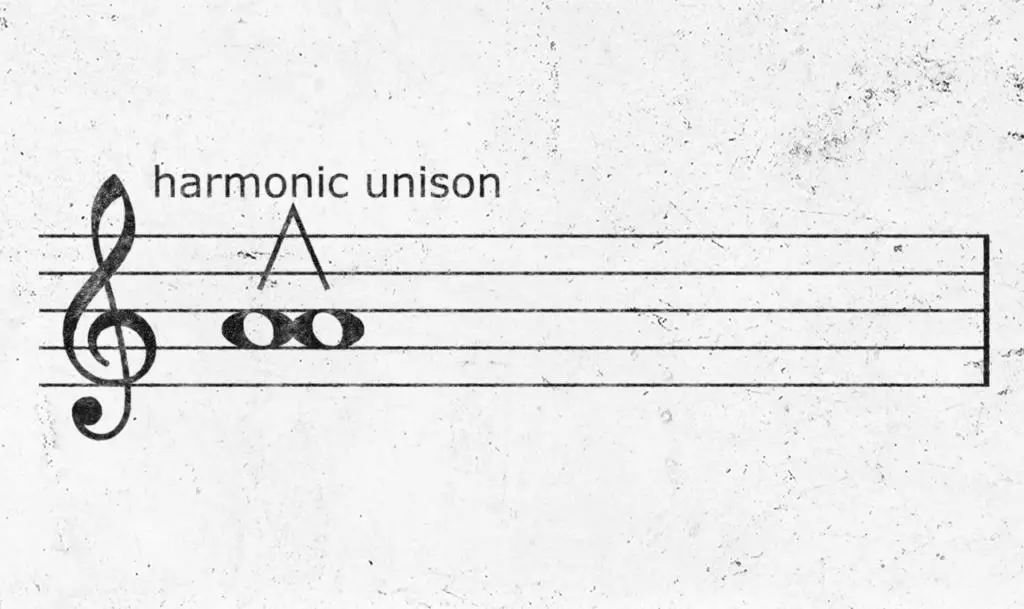In musical terms, unison is the act of playing or singing two or more parts together at the same pitch or octave.
This technique is commonly used in popular music genres such as rock, pop, and hip-hop, both in vocals and instrumentation. It allows for a fuller and more powerful sound, creating a sense of unity among the different parts. Creative use of unison in popular music production can lead to a dynamic and engaging listening experience for the audience.

What is Unison: Table of Contents
Unison refers to the phenomenon where two or more notes are played or sung at the same pitch, creating a harmonic effect that can be both powerful and beautiful.
The concept of unison has been a part of music since its earliest days, with the earliest known musical compositions featuring groups of singers or musicians singing or playing the same notes together.
Over time, the concept of unison has evolved, with composers and musicians using it in increasingly complex and nuanced ways to create a wide range of musical effects.
Understanding Unison
As a musician, it’s important to have a solid understanding of what unison means in music. In simple terms, unison refers to when two or more notes are played or sung at the same pitch or frequency. This creates a sense of unity and cohesion in the music and is a fundamental concept in music theory.
Identifying unison in music is relatively easy, as it is simply a matter of listening for two or more notes that sound the same. For example, if a guitar and a piano play the same note at the same time, they are playing in unison. Similarly, if a group of singers all sing the same note together, they are singing in unison.
While unison may seem like a simple concept, it plays a crucial role in music theory. It is considered one of the most basic intervals in Western music and serves as a reference point for other intervals. For example, a perfect fifth can be understood as the distance between the first and fifth notes in a major scale played in unison.
There are several types of unison that are important to be aware of. The most common is the perfect unison, which is when two notes are played at the same pitch with no variation. However, there is also rhythmic unison, which refers to when two or more musicians play the same rhythm at the same time, even if the pitches they are playing are different. This can create a powerful sense of unity in the music.
Unison in Performance
When it comes to musical performance, unison plays a critical role in creating a cohesive and impactful sound. Whether it’s instrumental or vocal music, the ability to play or sing in unison can make or break a performance.

In instrumental music, unison refers to playing the same notes at the same time. This can be as simple as playing a single melody line with a group of musicians, or as complex as performing a piece with multiple parts that must be played in perfect sync. Achieving unison in instrumental music requires careful listening and coordination among all performers.
In vocal music, unison is even more crucial, as singers must match not only the notes but also the timbre, tone, and expression of their fellow singers. In my experience singing in choirs, achieving unison can be a daunting task, but the payoff is well worth it. When a group of singers comes together in perfect unison, the result is a powerful and moving sound that can send shivers down your spine.
Choral music takes unison to the next level, as it requires a group of singers to perform as one cohesive unit. Choral singing is not just about hitting the right notes, but also about blending your voice with those around you to create a seamless and beautiful sound. Achieving unison in choral music requires not only careful listening and coordination but also a deep understanding of the music and the emotions it conveys.
Tuning and Intonation
When it comes to unison performance, one of the most critical aspects is tuning and intonation.
Tuning unison in various instruments can be a difficult task, as different instruments require different tuning methods. For example, a guitar player might use a tuner to tune each individual string, while a brass player might rely on their ear to match the pitch of the other performers. However, regardless of the method used, it is essential that all performers are in tune with each other to achieve a cohesive sound.
Intonation challenges in unison performance can also arise, particularly in larger ensembles. As a performer, it is essential to listen carefully to the other musicians and adjust one’s playing accordingly. It can be challenging to maintain good intonation when playing with others, especially if the performers have different playing styles or if the acoustics of the performance space are less than ideal.
Despite these challenges, good intonation is essential in unison performance. When all performers are in tune with each other, the music sounds more harmonious, and the audience can better appreciate the music. Good intonation can also convey emotion and help to create a specific mood, which is essential for musical performances.
Unison in Composition and Arrangement
Unison is an important aspect of music composition and arrangement. When used effectively, unison passages can create a powerful impact and bring a sense of unity to the music.
When arranging music for unison performance, it is important to consider the capabilities of the performers. Unison passages can be challenging to perform, especially if they involve difficult rhythms or intervals. Therefore, it is important to create arrangements that are appropriate for the skill level of the performers.
One of the challenges of unison performance is achieving good intonation. When multiple instruments or voices are playing or singing the same note, it is important that they are in tune with each other. However, achieving perfect unison is not always easy. Different instruments and voices have different timbres and tuning tendencies, which can make it difficult to achieve perfect intonation.
To overcome this challenge, it is important to train the performers to listen to each other and adjust their intonation accordingly. This can be done through rehearsal and practice, as well as through the use of electronic tuners and other tools.
Creating harmonies from unison passages can also be a powerful technique in music composition and arrangement. By adding additional voices or instruments that play different notes, a composer can create rich harmonies and textures that enhance the impact of the music.
Unison in Orchestration
Unison in orchestration is a powerful tool that can be used to create a wide range of musical textures. When used effectively, unison passages can add a sense of unity and power to a composition, while also allowing for more intricate and complex arrangements.
One of the key ways to use unison in orchestration is to balance it with other parts. Unison passages can be incredibly powerful, but they can also be overwhelming if they are overused. By balancing unison passages with other parts, such as harmonies or counterpoint, you can create a more nuanced and dynamic sound.
Another way to use unison in orchestration is to create different textures. For example, unison passages played by the strings can create a warm, rich texture, while unison passages played by the brass can create a bright and powerful sound. By using unison in different ways, you can create a more interesting and engaging composition.
Unison in Music Production
Unison is a powerful tool in music production that can help create rich, layered sounds that grab the listener’s attention. By using unison, producers can add depth and complexity to their tracks, making them stand out in a crowded market.
One way to use unison in music production is by layering sounds. By creating multiple instances of the same sound, detuning them slightly, and panning them across the stereo field, producers can create a sense of width and depth. This is particularly effective in electronic music genres, such as dubstep and trance, where the emphasis is on creating complex soundscapes.
Creating unison sounds in electronic music is relatively straightforward, thanks to the use of digital audio workstations (DAWs) and software synthesizers. Many software synthesizers, such as Serum and Massive, have built-in unison functions that allow producers to create thick, rich sounds with ease. By adjusting the detune, spread, and number of voices, producers can create a range of different textures and timbres.
In addition to layering sounds and using software synthesizers, producers can also use unison to create thick textures in production. By adding unison to a track’s lead or bassline, producers can create a sense of power and intensity. This is particularly effective in genres such as techno and house, where the emphasis is on creating driving, energetic tracks.
Unison in Popular Music
Unison is not only used in electronic music production, but it is also widely utilized in various popular music genres. In fact, the use of unison in popular music has been prevalent for decades and has become an integral part of many hit songs.
From rock to pop to hip-hop, unison is used to create a powerful impact in music. In rock music, unison is often used to emphasize the chorus or to create a memorable hook. Think about the iconic guitar riff in “Smoke on the Water” by Deep Purple, which is played in unison by the guitar and organ. The unison creates a powerful and catchy melody that makes the song instantly recognizable.
In pop music, unison is often used in vocals to create a sense of harmony and unity among the singers. When multiple singers sing in unison, it creates a sense of togetherness and amplifies the emotional impact of the lyrics. The song “We Are the World,” written by Michael Jackson and Lionel Richie, is a great example of the use of unison in vocals. In the chorus, all the singers come together to sing in unison, creating a powerful and emotional impact.
Hip-hop music also uses unison in unique and creative ways. In hip-hop production, unison is used to create thick textures and add depth to the beat. Producers often layer multiple sounds in unison to create a bigger and more powerful sound. This technique can be heard in many popular hip-hop songs, such as “Lose Yourself” by Eminem.
Unison can be used in instrumentation in popular music as well. In a band, multiple instruments can play the same melody in unison, creating a fuller and more impactful sound. The song “We Will Rock You” by Queen is a great example of the use of unison in instrumentation. The iconic drum beat and claps played in unison create a rhythmic and memorable sound that gets people moving.
In popular music production, unison can be used creatively to add unique textures and effects to the sound. For example, producers can use unison to create a chorus effect, which is often used in vocal production. By duplicating the vocal track and slightly detuning it, producers can create a thicker and more powerful sound. This technique can be heard in many popular songs, such as “Believe” by Cher.

